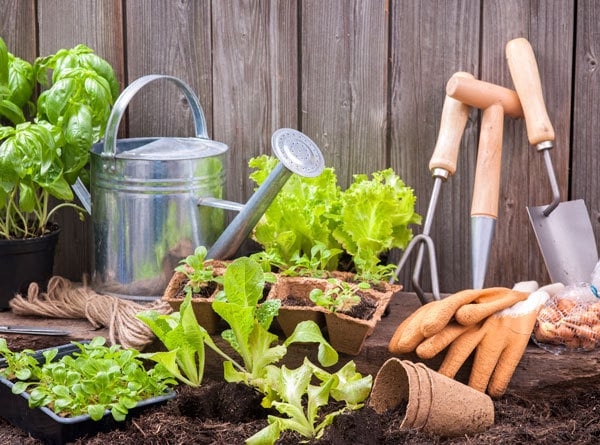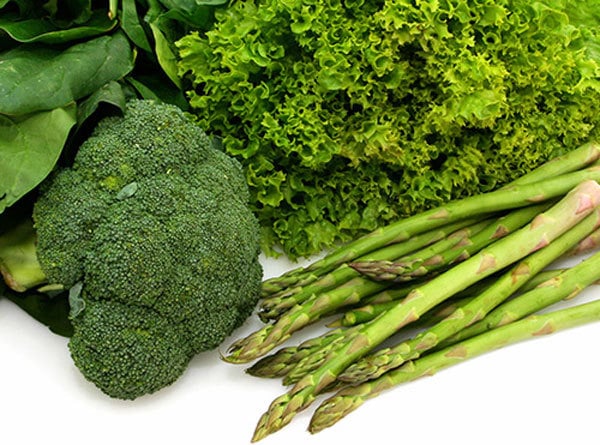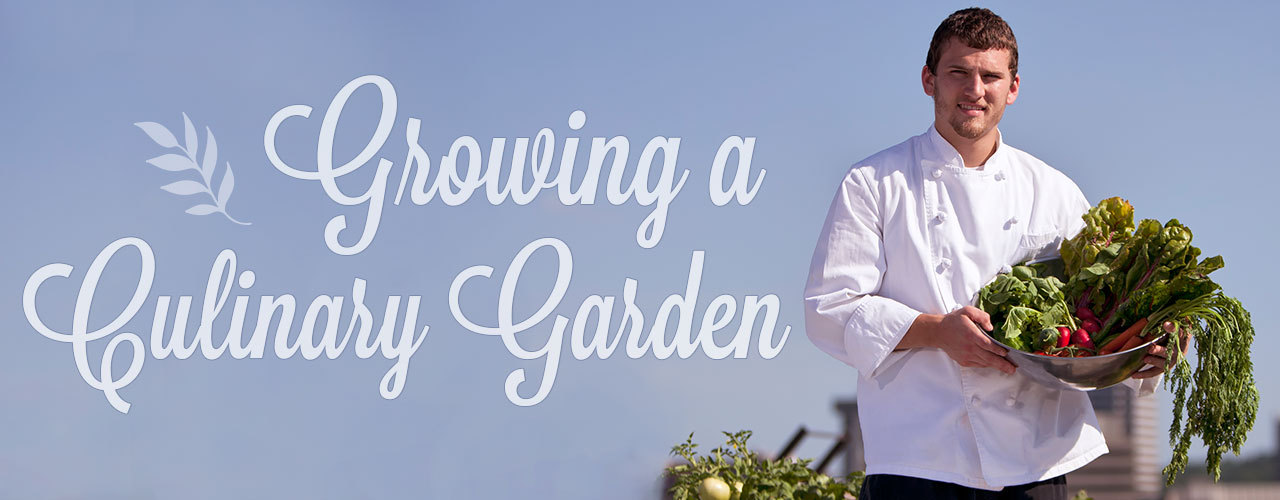Growing a Culinary Garden for Your Restaurant
Last updated on Mar 19, 2025Amber BurnsHome-growing produce for your commercial kitchen is a great way to give your dishes fresher flavors. With flowers, herbs, fruits, and vegetables growing only feet from your kitchen, your customers will not only taste stronger flavors on their plates, but they'll also experience the satisfaction of seeing exactly where their food came from.
What are the Benefits of a Culinary Garden?

- Larger Stock - Growing your own herbs and produce is a surefire way to know where your food came from. When other restaurants are worried about recalls or shortages, you’ll still be fully stocked. You can also grow uncommon herbs that can give your dishes unique flavors!
- Fresher, Better-Tasting Ingredients - Since the ingredients are growing only feet from your kitchen, they retain their strong flavors. Herbs sitting on a shelf lose their flavors over time. Having a culinary garden allows you to skip the storage shelf, resulting in better-tasting ingredients.
- Less Expensive - A packet of seeds will set you back a couple of dollars at most. Maintaining a small herb garden costs less than buying the same produce in a store or market.
- Environmental Benefits - Most people know that plants help filter the air we need to breathe, but using home-grown ingredients in your commercial cooking also cuts down on the packaging that store-bought produce comes in. Less packaging means less waste in landfills. It also cuts out a huge amount of carbon emissions that result from the transportation of goods from the farm to the store to the kitchen.
- Sense of Fulfillment - Tending to a garden can bring a tremendous sense of accomplishment and fulfillment. Studies suggest gardening can actually reduce the risk of diseases like depression and improve your mood. You can even use the garden as a team-building exercise to create a happier, more cohesive staff.
- Free Landscaping - In addition to their functionality, gardens also provide beautiful landscaping for any facility. Your customers will love having the leafy green plants and colorful flowers around, especially if your dining area is outside.
- Novelty - Culinary gardens are becoming popular in the same way that farm-to-table restaurants and locally-grown food have. Knowing where your ingredients come from makes it easier to know they are all-natural, with no pesticides or preservatives.
Where Can I Build a Garden?

It doesn’t matter where your restaurant is – you have plenty of space for a small herb or vegetable garden. Establishments in suburbs or country areas can easily build the garden on the lawn or behind the kitchen, for easy access.
Restaurants in the city tend not to have much, if any, yard space, but that doesn’t mean you can’t have a culinary garden! Urban agriculture is making a comeback. This can mean window boxes, rooftop gardens, or even plants on the fire escape. It doesn’t take very much space to grow fresh vegetables and herbs because just a few planters can be used to grow a wide variety. The plants themselves will stay small because you’ll constantly be using the leaves for cooking.
What Can I Grow?

To save space, different herbs can be planted in the same bed or planter. The golden rule for growing herbs together is that you should only combine herbs that require similar conditions. For instance, Mediterranean varieties like rosemary, oregano, lavender, sage, marjoram, and thyme require drier soil and lots of sunlight. Plants like parsley, basil, tarragon, and cilantro like lots of water and can grow in shadier areas. Always be sure to match up the growing information before you combine plants.
You can also grow fresh vegetables and fruits in planters and small culinary gardens! Tomatoes, green beans, cucumbers, and peas are all great choices because they can be trained to run vertically up trellises, maximizing your space. Popular fruits include strawberries and cantaloupes because they stay low to the ground, as opposed to tall fruit trees which take up much more room.
To add some color to your garden, you can also think about adding edible flowers. Violets and roses can be used as sweet garnishes on desserts, while bright blue borage petals taste like cucumbers and can be used in salads. Edible flowers are a beautiful, creative way to incorporate color into your culinary garden and your menu.
Fresh herbs, fruits, and veggies add fresh flavors to your signature dishes and look great in window boxes, pots, and plots of land. So whether you’re looking to expand the menu at your family Italian bistro or find a new draw your urban rooftop restaurant, a culinary garden might be a good option for you.
Related Resources

Produce Storage Guide for Restaurants
Efficient produce storage is a critical component of running a successful restaurant. Properly storing fruits and vegetables not only ensures their freshness and quality but also helps reduce food waste, ultimately saving your establishment money. By implementing effective storage practices, restaurants can prolong the shelf life of their produce, maintain flavor and nutritional value, and minimize spoilage. Below, we explore the best practices for storing various types of produce, helping you optimize your restaurant's operations and maximize your profitability. Use these links to learn more about the different aspects of storing restaurant produce: Best Way to Store Produce How to Store Fruits and Vegetables Chart What Is Ethylene? Ethylene Production and Sensitivity Chart How to Store Vegetables How to Store Fruit Best Way to Store Produce Below, we've listed some of the universal best practices for organizing your restaurant’s storeroom: Store produce at reduced temperatures to increase its shelf life. Don't stack produce. Pressure and lack of airflow shorten fresh produce’s lifespan. Keep produce unwashed in storage. When you’re ready to use your fresh items, make sure you wash your produce properly. Don't cut produce until you're ready to use it. Cut produce is vulnerable to microorganisms. Store your fresh produce where there is some airflow (not in airtight containers or bags). This prevents them from suffocating and spoiling faster. Don't buy fresh produce too far in advance. Produce loses its flavor and crispness when held at low temperatures for extended time periods. How to Store Fruits and Vegetables Chart When it comes to storing fruits and vegetables in a commercial setting, understanding the proper storage conditions is crucial to maintaining their freshness and quality. Different types of produce require specific temperatures and conditions to prolong their shelf life and prevent premature spoilage. Factors such as ethylene production and sensitivity also play a significant role in determining the storage requirements for fruits and vegetables. By following recommended guidelines for storage temperature, ethylene exposure, and handling practices, businesses can ensure that their seasonal produce stays fresh and appealing for an extended period. Printable Version What Is Ethylene? Ethylene is a plant hormone that makes seeds/buds sprout, ripens fruit, and causes plant cells to break down. Plants release ethylene as a gas. Understanding ethylene helps you extend the shelf life of your fruits and vegetables. The first thing you need to know is plants’ ethylene productions and sensitivities are not universal. So, you should store ethylene producers separate from ethylene-sensitive items. Savvy commercial kitchen operators manipulate ethylene to accelerate ripening. All you need to do is place a high ethylene producing fruit inside a paper bag with the item you want to ripen. The paper bag traps the ethylene gas, yielding ready-to-eat fruit faster. Climacteric Fruit Definition The term 'climacteric' is used to describe fruits that continue to ripen after they're picked. Climacteric fruits create and release far more ethylene than non-climacteric fruits. The term 'non-climacteric' describes fruits that don't ripen once they're picked. Top Ethylene Producing Fruits These common climacteric fruits are some of the top ethylene producers. Their ethylene potency increases as they ripen. Apples Avocados Bananas Cantaloupe Peaches Pears Ethylene Production and Sensitivity Chart As an easy-to-reference resource, we've created a downloadable produce storage chart you can keep in your commercial kitchen. Printable Version How to Store Vegetables On average, vegetables contain nonexistent traces of ethylene compared to fruits. Learn how to maximize the freshness and quality of the most popular vegetables below: Tomatoes - Tomatoes keep best when they aren’t touching, so store them in a single layer, stem side down. It's also important to keep tomatoes stored away from sunlight. Potatoes - Since refrigerated air is too cold for potatoes and causes their starch to turn to sugar, you should store potatoes outside of the fridge. Potatoes need to be stored in a cool, dark, dry spot, avoiding plastic bags/sealed containers that trap moisture. Cucumbers - To keep cucumbers fresh, wrap clean and dry cucumbers in a paper towel and place them inside a plastic bag. The plastic bag helps protect the cucumbers from ethylene gas. Leave the top of the bag open to provide airflow and help prevent molding and sogginess. Carrots - Carrot tops extract moisture from their roots, causing them to wilt prematurely. To avoid this, trim them before storing. Keep your carrots hydrated by storing them in an uncovered container of shallow water inside your fridge. Cabbage - To properly store cabbage in a restaurant setting, ensure that it is kept in a cool and humid environment, ideally at a temperature of around 32 to 40 degrees Fahrenheit. Cabbage should be stored in a perforated plastic bag or wrapped in a damp paper towel to maintain its moisture content. How to Store Fruits Learn how to store fruit to achieve complete ripeness and long shelf lives. While most fruits are ethylene producers, not all fruits release the same amount of ethylene, nor are they equally sensitive to it. Below are our tips for turning the most popular fruits into ripe and unspoiled ingredients: Bananas - Store bananas at room temperature until they ripen, then transfer them to the refrigerator to extend their shelf life. To prevent them from browning too quickly, you can wrap the stems in plastic wrap or separate the bunch into individual bananas. Grapes - Grapes should be stored in the refrigerator in a perforated plastic bag or a container with ventilation holes. This will help maintain their freshness and prevent mold growth. Avoid washing grapes until you are ready to eat them to prevent moisture buildup. Avocado - To ripen avocados quickly, place them in a paper bag. Once ripe, store them in the refrigerator to slow down the ripening process. If you only use part of an avocado, keep the pit in the remaining half and store it in an airtight container. Apples - Store apples in the refrigerator crisper drawer to keep them fresh. Make sure to separate any bruised or damaged apples from the rest to prevent them from spoiling the others. If you have sliced apples, sprinkle them with lemon juice to prevent browning before storing them in an airtight container. Oranges - Oranges can be stored at room temperature or in the refrigerator. If you choose to refrigerate them, place them in the crisper drawer to maintain their freshness. To keep peeled or sliced oranges fresh, store them in an airtight container in the refrigerator. When it comes to storing produce in your restaurant, proper handling and storage techniques are essential to maintain freshness, quality, and food safety. On average each year, every restaurant loses $25,000 to $75,000 due to wasted and spoiled food, something that can be remedied by proper storage techniques. Remember to store different types of produce separately, maintain proper temperature and humidity levels, and regularly inspect for signs of spoilage. Implementing these best practices will not only help you reduce food waste and save money but also provide your customers with the highest quality ingredients in your dishes.

Seasonal Fruits and Vegetables in Your Region
If you've ever asked, "When are pears in season?" or, "What are some examples of fall fruits?", you are not alone. With so many fruits and vegetables being imported from other states and countries, it can be hard to know what fruits are in season around your restaurant. Many consumers will pay more for local and organic fresh vegetables and fruits. You can take advantage of this restaurant trend and boost your profits by familiarizing yourself with your region's seasonal produce cycles. Skip to our interactive seasonal produce chart to find out what's in season in your region. Shop All Fruits and Vegetables Eating Seasonally If your establishment doesn’t have a culinary garden, it likely obtains produce from outside sources. Although non-local and out-of-season produce gets the job done, many people prefer the health and environmental benefits that come with eating seasonally, shifting the focus of restaurants towards locally grown, in-season food. Here are a few of the benefits of eating in-season vegetables and fruits. Increased Nutrition - On average, seasonal fruits and vegetables contain many more nutrients than their frozen or out-of-season counterparts. The process of preserving and protecting fruits and vegetables for long-term storage can sap produce of their nutritional value, meaning in-season produce will almost always be packed with more nutrients. Better Taste - In addition to being more nutritious, in-season fruits and vegetables are often thought of as better tasting than out-of-season produce. Farmers that look to mass-produce fruits and vegetables prioritize shelf-life over taste, allowing the produce to be stored for long periods and survive being shipped across the country. As a result, you’ll often find that locally grown in-season vegetables have more flavor. Lower Costs - Thanks to its abundant supply, in-season produce is often much cheaper. Out-of-season produce isn’t as plentiful, resulting in higher prices. Additionally, extra costs need to be added to out-of-season produce to cover aspects such as transportation and preservation, further inflating prices. Eating in-season produce is not only good for your health, but it’s great for your wallet. Reduced Carbon Footprint - Consuming in-season vegetables and fruit is a great way to reduce your carbon footprint and have a positive impact on the environment. Out-of-season produce typically requires hundreds of miles of transportation, which results in the burning of many fossil fuels and emissions entering the atmosphere. If you eat local in-season produce, your food doesn’t have to travel as far to reach you, greatly cutting back on emissions. Decreased Pesticide Consumption - Out-of-season produce is usually filled with a variety of pesticides and preservatives to maintain freshness and quality throughout the food’s entire journey. Although properly cleaning out-of-season fruits and vegetables can remove some chemicals, there may be some remaining. However, in-season vegetables and fruits don’t require as much preservation through chemicals, meaning eating in-season produce will greatly reduce the number of pesticides you consume. What Produce Is in Season? Depending on what time of the year it is and what region of the United States you are located in, different produce will be in season. For example, spring produce in the Northeast consists of foods such as different types of mushrooms, rhubarb, and cherries, while spring produce in the Southwest includes corn, avocados, and apricots. Learning what fruits and vegetables are in season in your region is important if you’re looking to use fresh ingredients and create the best dishes possible. Produce Calendar Cooking with local, fresh seasonal vegetables and herbs is delicious, healthy, and easy to do with this convenient guide. We've broken down the contiguous United States into regions, so you can see the fruits and vegetables in season in your part of the country all year round. As you explore, it’s important to keep in mind that these lists may vary depending on where you live, even within a certain region. Be sure to research your area using information from your local government or food guides to find what vegetables are in season near you. <label class="subtlelabel">Select a season</label> Spring Summer Fall Winter <label class="subtlelabel">Select a region</label> Fall Vegetables and Fruits in the Northwest There is no shortage of delicious fall vegetables available in the Northwest, including bulbs like fennel, garlic, leeks, and onions, all of which are perfect for seasoning dishes or making sauces. If your business serves a lot of salads, you'll also love the Northwest's selection of arugula, carrots, cucumbers, kale, lettuce, mushrooms, peppers, salad greens, spinach, and tomatoes. <label class="produce-title">Apples</label> <label class="produce-title">Artichokes</label> <label class="produce-title">Arugula</label> <label class="produce-title">Beets</label> <label class="produce-title">Brussels Sprouts</label> <label class="produce-title">Cabbage</label> <label class="produce-title">Cantaloupes</label> <label class="produce-title">Carrots</label> <label class="produce-title">Celery</label> <label class="produce-title">Chard</label> <label class="produce-title">Collards</label> <label class="produce-title">Corn</label> <label class="produce-title">Cucumbers</label> <label class="produce-title">Eggplant</label> <label class="produce-title">Fennel</label> <label class="produce-title">Garlic</label> <label class="produce-title">Grapes</label> <label class="produce-title">Kale</label> <label class="produce-title">Leeks</label> <label class="produce-title">Lettuce</label> <label class="produce-title">Mushrooms</label> <label class="produce-title">Onions</label> <label class="produce-title">Parsnips</label> <label class="produce-title">Pears</label> <label class="produce-title">Peppers</label> <label class="produce-title">Potatoes</label> <label class="produce-title">Pumpkins</label> <label class="produce-title">Radishes</label> <label class="produce-title">Salad Greens</label> <label class="produce-title">Spinach</label> <label class="produce-title">Squash</label> <label class="produce-title">Tomatoes</label> <label class="produce-title">Turnips</label> <label class="produce-title">Zucchini</label> Fall Vegetables and Fruits in the Midwest Green, seasonal vegetables are abundant in the Midwest during the autumn months, such as broccoli, celery, cucumbers, kale, lettuce, spinach, and zucchini. There are also plenty of leafy greens available, like broccoli, brussels sprouts, cabbage, and cauliflower. If you're looking for fall fruit, you'll need to import everything you need other than apples and pears. <label class="produce-title">Apples</label> <label class="produce-title">Beets</label> <label class="produce-title">Broccoli</label> <label class="produce-title">Brussels Sprouts</label> <label class="produce-title">Cabbage</label> <label class="produce-title">Carrots</label> <label class="produce-title">Cauliflower</label> <label class="produce-title">Celery</label> <label class="produce-title">Chard</label> <label class="produce-title">Cucumbers</label> <label class="produce-title">Eggplant</label> <label class="produce-title">Garlic</label> <label class="produce-title">Kale</label> <label class="produce-title">Leeks</label> <label class="produce-title">Lettuce</label> <label class="produce-title">Mushrooms</label> <label class="produce-title">Onions</label> <label class="produce-title">Parsnips</label> <label class="produce-title">Pears</label> <label class="produce-title">Pumpkins</label> <label class="produce-title">Radishes</label> <label class="produce-title">Salad Greens</label> <label class="produce-title">Spinach</label> <label class="produce-title">Squash</label> <label class="produce-title">Tomatoes</label> <label class="produce-title">Turnips</label> <label class="produce-title">Zucchini</label> Fall Vegetables and Fruits in the Northeast Seasonal vegetables are plentiful in the Northeast during the autumn months, and the region ships these products to businesses around the country. Fall fruit is less common, but you'll still be able to find plenty of apples, cranberries, grapes, and pears to go around. If you're looking for other seasonal fruits, consider buying from distributors in the South and Southwest regions. <label class="produce-title">Apples</label> <label class="produce-title">Beets</label> <label class="produce-title">Broccoli</label> <label class="produce-title">Brussels Sprouts</label> <label class="produce-title">Cabbage</label> <label class="produce-title">Cauliflower</label> <label class="produce-title">Celery</label> <label class="produce-title">Chard</label> <label class="produce-title">Collards</label> <label class="produce-title">Cranberries</label> <label class="produce-title">Cucumbers</label> <label class="produce-title">Eggplant</label> <label class="produce-title">Fennel</label> <label class="produce-title">Garlic</label> <label class="produce-title">Grapes</label> <label class="produce-title">Kale</label> <label class="produce-title">Leeks</label> <label class="produce-title">Lettuce</label> <label class="produce-title">Mushrooms</label> <label class="produce-title">Onions</label> <label class="produce-title">Parsnips</label> <label class="produce-title">Pears</label> <label class="produce-title">Peas</label> <label class="produce-title">Peppers</label> <label class="produce-title">Potatoes</label> <label class="produce-title">Pumpkins</label> <label class="produce-title">Radishes</label> <label class="produce-title">Salad Greens</label> <label class="produce-title">Spinach</label> <label class="produce-title">Squash</label> <label class="produce-title">Sweet Potatoes</label> <label class="produce-title">Turnips</label> Fall Vegetables and Fruits in the Southwest The Southwest is full of delicious crops during the autumn months, including avocados, dates, figs, limes, and pomegranates. You'll also find a host of fall root vegetables, such as carrots, leeks, parsnips, potatoes, radishes, sweet potatoes, and turnips. If your restaurant or grocery store is located in the Southwest, you won't need to import much, which will help your budget and keep your inventory stocked. <label class="produce-title">Apples</label> <label class="produce-title">Arugula</label> <label class="produce-title">Avocados</label> <label class="produce-title">Broccoli</label> <label class="produce-title">Brussels Sprouts</label> <label class="produce-title">Carrots</label> <label class="produce-title">Cauliflower</label> <label class="produce-title">Chard</label> <label class="produce-title">Collards</label> <label class="produce-title">Corn</label> <label class="produce-title">Dates</label> <label class="produce-title">Figs</label> <label class="produce-title">Green Beans</label> <label class="produce-title">Kale</label> <label class="produce-title">Leeks</label> <label class="produce-title">Lettuce</label> <label class="produce-title">Limes</label> <label class="produce-title">Mushrooms</label> <label class="produce-title">Parsnips</label> <label class="produce-title">Peppers</label> <label class="produce-title">Pomegranates</label> <label class="produce-title">Potatoes</label> <label class="produce-title">Pumpkins</label> <label class="produce-title">Radishes</label> <label class="produce-title">Raspberries</label> <label class="produce-title">Spinach</label> <label class="produce-title">Squash</label> <label class="produce-title">Sweet Potatoes</label> <label class="produce-title">Tomatoes</label> <label class="produce-title">Turnips</label> Fall Vegetables and Fruits in the South Some of the South's signature crops are still going strong in autumn, including collards, okra, and sweet potatoes. You'll also find gourds like pumpkins and squash, along with kale, lettuce, and spinach for salads and side dishes. If your business bakes pies, you'll have plenty of apples and peaches to choose from. <label class="produce-title">Apples</label> <label class="produce-title">Cabbage</label> <label class="produce-title">Collards</label> <label class="produce-title">Cucumbers</label> <label class="produce-title">Grapes</label> <label class="produce-title">Kale</label> <label class="produce-title">Leeks</label> <label class="produce-title">Lettuce</label> <label class="produce-title">Okra</label> <label class="produce-title">Peaches</label> <label class="produce-title">Peppers</label> <label class="produce-title">Pumpkins</label> <label class="produce-title">Salad Greens</label> <label class="produce-title">Spinach</label> <label class="produce-title">Squash</label> <label class="produce-title">Sweet Potatoes</label> <label class="produce-title">Tomatoes</label> Spring Vegetables and Fruits in the Northwest Spring in the Northwest is similar to the Midwest: it's all about root vegetables. From carrots and fennel to potatoes and radishes, you'll be able to prepare these spring vegetables in a variety of styles while also creating delicious purees. The region also offers plenty of cruciferous greens like cabbage and chard, but you'll need to import most of your spring fruit. <label class="produce-title">Arugula</label> <label class="produce-title">Asparagus</label> <label class="produce-title">Cabbage</label> <label class="produce-title">Carrots</label> <label class="produce-title">Chard</label> <label class="produce-title">Collards</label> <label class="produce-title">Fennel</label> <label class="produce-title">Kale</label> <label class="produce-title">Lettuce</label> <label class="produce-title">Mushrooms</label> <label class="produce-title">Potatoes</label> <label class="produce-title">Radishes</label> <label class="produce-title">Rhubarb</label> <label class="produce-title">Salad Greens</label> <label class="produce-title">Spinach</label> <label class="produce-title">Strawberries</label> Spring Vegetables and Fruits in the Midwest While there isn't an overabundance of spring fruit available in the Midwest, you'll have no trouble finding plenty of fresh seasonal vegetables to add to your favorite dishes. Some of the Midwest's signature spring root vegetables are plentiful, including beets, carrots, parsnips, and radishes. Because fresh spring fruit isn't readily available, you'll need to import those items from other areas. <label class="produce-title">Arugula</label> <label class="produce-title">Asparagus</label> <label class="produce-title">Beets</label> <label class="produce-title">Carrots</label> <label class="produce-title">Lettuce</label> <label class="produce-title">Mushrooms</label> <label class="produce-title">Parsnips</label> <label class="produce-title">Peppers</label> <label class="produce-title">Radishes</label> <label class="produce-title">Rhubarb</label> <label class="produce-title">Salad Greens</label> <label class="produce-title">Spinach</label> Spring Vegetables and Fruits in the Northeast Spring is a bountiful and beautiful time in the Northeast region of the country. You'll find plenty of spring root vegetables in season (like carrots, beets, parsnips, and radishes), but leafy greens like chard, spinach, and arugula are also prevalent. If you're looking for seasonal citrus fruits such as grapefruit, oranges, or lemons for your drinks or desserts, you'll need to import them from the South or Southwest regions. <label class="produce-title">Arugula</label> <label class="produce-title">Asparagus</label> <label class="produce-title">Beets</label> <label class="produce-title">Broccoli</label> <label class="produce-title">Cabbage</label> <label class="produce-title">Carrots</label> <label class="produce-title">Cauliflower</label> <label class="produce-title">Chard</label> <label class="produce-title">Cherries</label> <label class="produce-title">Garlic</label> <label class="produce-title">Kale</label> <label class="produce-title">Lettuce</label> <label class="produce-title">Mushrooms</label> <label class="produce-title">Parsnips</label> <label class="produce-title">Peas</label> <label class="produce-title">Radishes</label> <label class="produce-title">Rhubarb</label> <label class="produce-title">Salad Greens</label> <label class="produce-title">Spinach</label> <label class="produce-title">Strawberries</label> Spring Vegetables and Fruits in the Southwest If your guests are craving guacamole, you'll love the Southwest's abundance of avocados. There are also plenty of leafy greens close at hand for salads and sides, including chard, kale, lettuce, and spinach. Additionally, you'll find fruits and vegetables in season that aren’t as common in the rest of the country, such as figs and squash. <label class="produce-title">Apricots</label> <label class="produce-title">Arugula</label> <label class="produce-title">Asparagus</label> <label class="produce-title">Avocados</label> <label class="produce-title">Broccoli</label> <label class="produce-title">Cabbage</label> <label class="produce-title">Carrots</label> <label class="produce-title">Cauliflower</label> <label class="produce-title">Celery</label> <label class="produce-title">Chard</label> <label class="produce-title">Collards</label> <label class="produce-title">Corn</label> <label class="produce-title">Cucumbers</label> <label class="produce-title">Eggplant</label> <label class="produce-title">Figs</label> <label class="produce-title">Garlic</label> <label class="produce-title">Grapefruit</label> <label class="produce-title">Green Beans</label> <label class="produce-title">Kale</label> <label class="produce-title">Leeks</label> <label class="produce-title">Lemons</label> <label class="produce-title">Lettuce</label> <label class="produce-title">Mushrooms</label> <label class="produce-title">Nectarines</label> <label class="produce-title">Onions</label> <label class="produce-title">Oranges</label> <label class="produce-title">Peaches</label> <label class="produce-title">Peas</label> <label class="produce-title">Potatoes</label> <label class="produce-title">Radishes</label> <label class="produce-title">Spinach</label> <label class="produce-title">Squash</label> <label class="produce-title">Strawberries</label> <label class="produce-title">Tomatoes</label> <label class="produce-title">Turnips</label> <label class="produce-title">Zucchini</label> Spring Vegetables and Fruits in the South When it comes to spring in the South, you'll find plenty of seasonal green vegetables to go around, such as lettuce and spinach. Traditional Southern favorites are also plentiful, including collards, okra, and sweet potatoes. The South is also a great source of spring citrus fruit, particularly grapefruit and oranges. <label class="produce-title">Asparagus</label> <label class="produce-title">Beets</label> <label class="produce-title">Blueberries</label> <label class="produce-title">Broccoli</label> <label class="produce-title">Cabbage</label> <label class="produce-title">Cauliflower</label> <label class="produce-title">Collards</label> <label class="produce-title">Corn</label> <label class="produce-title">Cucumbers</label> <label class="produce-title">Eggplant</label> <label class="produce-title">Grapefruit</label> <label class="produce-title">Green Beans</label> <label class="produce-title">Lettuce</label> <label class="produce-title">Mangoes (Florida)</label> <label class="produce-title">Okra</label> <label class="produce-title">Oranges</label> <label class="produce-title">Peaches</label> <label class="produce-title">Peppers</label> <label class="produce-title">Plums</label> <label class="produce-title">Pumpkins</label> <label class="produce-title">Salad Greens</label> <label class="produce-title">Spinach</label> <label class="produce-title">Squash</label> <label class="produce-title">Sweet Potatoes</label> <label class="produce-title">Tomatoes</label> <label class="produce-title">Strawberries</label> Summer Vegetables and Fruits in the Northwest Summer in the Northwest supplies a cornucopia of delicious seasonal fruits and summer vegetables, including unique varieties like artichokes, chilies, and garlic. The area is also known for seasonal root vegetables, such as beets, carrots, fennel, leeks, onions, parsnips, potatoes, and turnips. If your business is located in this area, you won’t need to import much during the summer, which will help your bottom line. <label class="produce-title">Apples</label> <label class="produce-title">Apricots</label> <label class="produce-title">Artichokes</label> <label class="produce-title">Arugula</label> <label class="produce-title">Asparagus</label> <label class="produce-title">Beets</label> <label class="produce-title">Blueberries</label> <label class="produce-title">Broccoli</label> <label class="produce-title">Cabbage</label> <label class="produce-title">Cantaloupes</label> <label class="produce-title">Carrots</label> <label class="produce-title">Cauliflower</label> <label class="produce-title">Chard</label> <label class="produce-title">Cherries</label> <label class="produce-title">Chili Peppers</label> <label class="produce-title">Collards</label> <label class="produce-title">Corn</label> <label class="produce-title">Cucumbers</label> <label class="produce-title">Eggplant</label> <label class="produce-title">Fennel</label> <label class="produce-title">Figs</label> <label class="produce-title">Garlic</label> <label class="produce-title">Grapes</label> <label class="produce-title">Kale</label> <label class="produce-title">Leeks</label> <label class="produce-title">Lettuce</label> <label class="produce-title">Mushrooms</label> <label class="produce-title">Nectarines</label> <label class="produce-title">Onions</label> <label class="produce-title">Parsnips</label> <label class="produce-title">Pears</label> <label class="produce-title">Peas</label> <label class="produce-title">Peppers</label> <label class="produce-title">Plums</label> <label class="produce-title">Potatoes</label> <label class="produce-title">Radishes</label> <label class="produce-title">Raspberries</label> <label class="produce-title">Rhubarb</label> <label class="produce-title">Salad Greens</label> <label class="produce-title">Spinach</label> <label class="produce-title">Squash</label> <label class="produce-title">Strawberries</label> <label class="produce-title">Tomatoes</label> <label class="produce-title">Turnips</label> <label class="produce-title">Watermelon</label> <label class="produce-title">Zucchini</label> Summer Vegetables and Fruits in the Midwest Predictably enough, corn is one of the Midwest's bumper crops over the summer months. You'll also find plenty of grapes to use at your winery or sell at your farmer's market. Additionally, there is an abundance of cucumbers, eggplant, squash, and zucchini to incorporate into all of your favorite appetizers, salads, and entrees. <label class="produce-title">Apples</label> <label class="produce-title">Arugula</label> <label class="produce-title">Asparagus</label> <label class="produce-title">Beets</label> <label class="produce-title">Blueberries</label> <label class="produce-title">Broccoli</label> <label class="produce-title">Brussels Sprouts</label> <label class="produce-title">Cabbage</label> <label class="produce-title">Cantaloupes</label> <label class="produce-title">Carrots</label> <label class="produce-title">Cauliflower</label> <label class="produce-title">Celery</label> <label class="produce-title">Chard</label> <label class="produce-title">Cherries</label> <label class="produce-title">Corn</label> <label class="produce-title">Cucumbers</label> <label class="produce-title">Eggplant</label> <label class="produce-title">Garlic</label> <label class="produce-title">Grapes</label> <label class="produce-title">Kale</label> <label class="produce-title">Leeks</label> <label class="produce-title">Lettuce</label> <label class="produce-title">Mushrooms</label> <label class="produce-title">Onions</label> <label class="produce-title">Peaches</label> <label class="produce-title">Pears</label> <label class="produce-title">Peas</label> <label class="produce-title">Peppers</label> <label class="produce-title">Plums</label> <label class="produce-title">Potatoes</label> <label class="produce-title">Pumpkins</label> <label class="produce-title">Radishes</label> <label class="produce-title">Raspberries</label> <label class="produce-title">Rhubarb</label> <label class="produce-title">Salad Greens</label> <label class="produce-title">Spinach</label> <label class="produce-title">Squash</label> <label class="produce-title">Strawberries</label> <label class="produce-title">Tomatoes</label> <label class="produce-title">Turnips</label> <label class="produce-title">Watermelon</label> <label class="produce-title">Zucchini</label> Summer Vegetables and Fruits in the Northeast Summer in the Northeast is bursting with almost every seasonal fruit and vegetable imaginable. If your restaurant or bakery sells pie, you’ll love having apples, blueberries, cherries, peaches, rhubarb, and strawberries close at hand. You'll also find a host of other perennial produce favorites, including brussel sprouts, eggplant, pumpkins, and watermelon. <label class="produce-title">Apples</label> <label class="produce-title">Arugula</label> <label class="produce-title">Asparagus</label> <label class="produce-title">Beets</label> <label class="produce-title">Beans</label> <label class="produce-title">Blueberries</label> <label class="produce-title">Broccoli</label> <label class="produce-title">Brussels Sprouts</label> <label class="produce-title">Cabbage</label> <label class="produce-title">Cantaloupes</label> <label class="produce-title">Carrots</label> <label class="produce-title">Cauliflower</label> <label class="produce-title">Celery</label> <label class="produce-title">Chard</label> <label class="produce-title">Cherries</label> <label class="produce-title">Collards</label> <label class="produce-title">Corn</label> <label class="produce-title">Cucumbers</label> <label class="produce-title">Eggplant</label> <label class="produce-title">Fennel</label> <label class="produce-title">Garlic</label> <label class="produce-title">Grapes</label> <label class="produce-title">Green Beans</label> <label class="produce-title">Kale</label> <label class="produce-title">Leeks</label> <label class="produce-title">Lettuce</label> <label class="produce-title">Mushrooms</label> <label class="produce-title">Nectarines</label> <label class="produce-title">Okra</label> <label class="produce-title">Onions</label> <label class="produce-title">Peaches</label> <label class="produce-title">Pears</label> <label class="produce-title">Peas</label> <label class="produce-title">Peppers</label> <label class="produce-title">Plums</label> <label class="produce-title">Potatoes</label> <label class="produce-title">Pumpkins</label> <label class="produce-title">Radishes</label> <label class="produce-title">Raspberries</label> <label class="produce-title">Rhubarb</label> <label class="produce-title">Salad Greens</label> <label class="produce-title">Spinach</label> <label class="produce-title">Squash</label> <label class="produce-title">Strawberries</label> <label class="produce-title">Sweet Potatoes</label> <label class="produce-title">Tomatoes</label> <label class="produce-title">Turnips</label> <label class="produce-title">Watermelon</label> <label class="produce-title">Zucchini</label> Summer Vegetables and Fruits in the Southwest Summer in the Southwest is all about summer fruit, including apples, blueberries, grapes, nectarines, peaches, pears, plums, raspberries, and watermelon. Pomegranates are also plentiful in the region during the summer months. These states are perhaps best known for their chilies, which come in a variety of types and are perfect for use in any spicy dish. <label class="produce-title">Apples</label> <label class="produce-title">Arugula</label> <label class="produce-title">Blueberries</label> <label class="produce-title">Cantaloupes</label> <label class="produce-title">Chilis</label> <label class="produce-title">Corn</label> <label class="produce-title">Cucumbers</label> <label class="produce-title">Eggplant</label> <label class="produce-title">Figs</label> <label class="produce-title">Garlic</label> <label class="produce-title">Grapes</label> <label class="produce-title">Green Beans</label> <label class="produce-title">Leeks</label> <label class="produce-title">Mushrooms</label> <label class="produce-title">Nectarines</label> <label class="produce-title">Okra</label> <label class="produce-title">Onions</label> <label class="produce-title">Peaches</label> <label class="produce-title">Pears</label> <label class="produce-title">Peppers</label> <label class="produce-title">Plums</label> <label class="produce-title">Pomegranates</label> <label class="produce-title">Potatoes</label> <label class="produce-title">Pumpkins</label> <label class="produce-title">Raspberries</label> <label class="produce-title">Squash</label> <label class="produce-title">Tomatoes</label> <label class="produce-title">Watermelon</label> <label class="produce-title">Zucchini</label> Summer Vegetables and Fruits in the South The South is jam-packed with vegetables in season during the summer months, including asparagus, cabbage, cauliflower, green beans, peas, and tomatoes. Your guests will also love the delicious seasonal fruits available in the South over the summer, such as peaches and plums. <label class="produce-title">Apples</label> <label class="produce-title">Asparagus</label> <label class="produce-title">Beets</label> <label class="produce-title">Blueberries</label> <label class="produce-title">Cabbage</label> <label class="produce-title">Cantaloupes</label> <label class="produce-title">Cauliflower</label> <label class="produce-title">Collards</label> <label class="produce-title">Corn</label> <label class="produce-title">Cucumbers</label> <label class="produce-title">Eggplant</label> <label class="produce-title">Figs</label> <label class="produce-title">Grapes</label> <label class="produce-title">Green Beans</label> <label class="produce-title">Okra</label> <label class="produce-title">Oranges</label> <label class="produce-title">Peaches</label> <label class="produce-title">Peas</label> <label class="produce-title">Peppers</label> <label class="produce-title">Plums</label> <label class="produce-title">Potatoes</label> <label class="produce-title">Pumpkins</label> <label class="produce-title">Raspberries</label> <label class="produce-title">Salad Greens</label> <label class="produce-title">Spinach</label> <label class="produce-title">Squash</label> <label class="produce-title">Sweet Potatoes</label> <label class="produce-title">Tomatoes</label> <label class="produce-title">Watermelon</label> Winter Vegetables and Fruits in the Northwest The Northwest is one of the best places to procure winter root vegetables, as they have plenty of beets, carrots, fennel, leeks, parsnips, potatoes, and turnips to go around. The region also has clementines, a unique winter citrus fruit that is a popular item in grocery stores nationwide. <label class="produce-title">Beets</label> <label class="produce-title">Brussels Sprouts</label> <label class="produce-title">Cabbage</label> <label class="produce-title">Carrots</label> <label class="produce-title">Chard</label> <label class="produce-title">Clementines</label> <label class="produce-title">Collards</label> <label class="produce-title">Fennel</label> <label class="produce-title">Kale</label> <label class="produce-title">Leeks</label> <label class="produce-title">Mushrooms</label> <label class="produce-title">Parsnips</label> <label class="produce-title">Potatoes</label> <label class="produce-title">Salad Greens</label> <label class="produce-title">Squash</label> <label class="produce-title">Turnips</label> Winter Vegetables and Fruits in the Midwest Like the Northeast, there aren't many winter fruits and seasonal vegetables to choose from during the cold months in the Midwest. You'll need to import everything other than mushrooms, which are always bountiful. <label class="produce-title">Mushrooms</label> Winter Vegetables and Fruits in the Northeast The Northeast doesn't have much to offer over the winter months due to snow and cold temperatures, so you'll need to import all of your winter fruits and vegetables other than mushrooms and parsnips. <label class="produce-title">Mushrooms</label> <label class="produce-title">Parsnips</label> Winter Vegetables and Fruits in the Southwest If your business needs citrus over the winter months, the Southwest is your best bet. Boasting everything from grapefruit and lemons to oranges and tangerines, this region also produces delicious strawberries. Additionally, you'll find plenty of avocados for your Mexican restaurant and broccoli, carrots, and cauliflower for vegetable medleys. <label class="produce-title">Arugula</label> <label class="produce-title">Avocados</label> <label class="produce-title">Broccoli</label> <label class="produce-title">Brussels Sprouts</label> <label class="produce-title">Cabbage</label> <label class="produce-title">Carrots</label> <label class="produce-title">Cauliflower</label> <label class="produce-title">Chard</label> <label class="produce-title">Collards</label> <label class="produce-title">Garlic</label> <label class="produce-title">Grapefruit</label> <label class="produce-title">Kale</label> <label class="produce-title">Leeks</label> <label class="produce-title">Lettuce</label> <label class="produce-title">Lemons</label> <label class="produce-title">Mushrooms</label> <label class="produce-title">Oranges</label> <label class="produce-title">Parsnips</label> <label class="produce-title">Radishes</label> <label class="produce-title">Spinach</label> <label class="produce-title">Squash</label> <label class="produce-title">Strawberries</label> <label class="produce-title">Sweet Potatoes</label> <label class="produce-title">Tangerines</label> <label class="produce-title">Turnips</label> Winter Vegetables and Fruits in the South Citrus is abundant in the South during the winter, with grapefruit and oranges leading the way. You'll also find a variety of leafy greens, including collards, kale, lettuce, and spinach. Apples are plentiful, too, which is good news for restaurants and bakeries. <label class="produce-title">Apples</label> <label class="produce-title">Collards</label> <label class="produce-title">Grapefruit</label> <label class="produce-title">Kale</label> <label class="produce-title">Lettuce</label> <label class="produce-title">Oranges</label> <label class="produce-title">Salad Greens</label> <label class="produce-title">Spinach</label>

What To Do With Overripe Fruits and Vegetables
While overripe fruits and vegetables may not be ideal, it doesn’t mean they’re unusable in the kitchen. Instead of contributing to the country’s billions of pounds of food waste, get creative with your sprouting spuds, pruney peaches, and brown bananas. Below are a few uses for overripe fruits and vegetables, as well as a few specific solutions for giving common culprits a second life. Ways to Use Overripe Vegetables Having an abundance of fresh, in-season vegetables means you may not get to enjoying them all in a timely manner. If your vegetables are starting to lose their visual appeal, consider using them in any of the following ways: Make a soup or stew: Throw veggies, broth, and spices and herbs into a stock pot and let them simmer to perfection. Or, puree softened carrots, cauliflower, or potatoes with milk to make a creamy fall or winter soup. Offer seasonal dishes: Create zucchini noodles in the summertime or pumpkin ravioli in the fall to make the most out of your seasonal produce. Create a pasta sauce: Overripe tomatoes can be peeled and simmered down to produce a flavorful sauce used on subs, pizzas, spaghetti, or with mozzarella sticks. Blend a salad dressing: Throw carrots, green peppers, red onions, and cucumbers into a blender or food processor along with oil, vinegar, and spices. Drizzle the final product over a bed of mixed greens. Pickle vegetables: Aside from cucumbers, you can pickle a number of overripe vegetables including banana peppers, mushrooms, radishes, and tomatoes. Make veggie chips: Slicing vegetables thin and roasting them in the oven with an abundance of spice can bring new life into soft, old produce. Ways to Use Overripe Fruit Overripe fruit can often contain even sweeter, juicier flavors than fresh fruits. This makes them a great addition to a number of recipes, with some recipes calling them out specifically. Below are a few creative and delicious ways to use overripe fruit in your kitchen: Make a smoothie: Soft fruits are pureed into a delicious blend of flavors when combined with ice, milk, yogurt, or orange juice. Squeeze fruit juice: The juices from overripe fruits are perfect for making fresh beverages, such as lemonade and classic OJ. Create fruit jams: Fruit jams, such as strawberry, grape, or raspberry, capture the sweet essence of fruit no matter how fresh or ripe they are. Simply muddle the fruit, add to a sauce pan, and mix with sugar and fruit juice. Bake a quick bread: Use old bananas to make a loaf of classic banana bread, or get creative with other baked goods including peach muffins, raspberry scones, and blueberry pancakes. Flavor ice cream: If you’re proudly serving homemade ice cream, incorporate the sweet flavors of strawberries, peaches, blueberries, or bananas into your chocolate or vanilla base. Examples for Specific Fruits and Vegetables If you have a specific fruit or vegetable you’re still unsure about, check out the list below of common types of overripe produce to learn what to do with it. What to Do with Overripe Bananas Here are a few common uses for overripe bananas: Bake banana bread, muffins, or pancakes Replace one egg with a ripe banana when baking Freeze and blend to produce banana ice cream What to Do with Overripe Peaches Overripe peaches offer a sweet flavor and soft, juicy texture perfect for pairing with a number of recipes. Here are a few creative ways to incorporate overripe peaches into your favorite recipes: Create peach salsa or peach curry Mix into butter to produce a peach butter Combine overripe peaches with milk, honey, and yogurt and freeze to make peach popsicles Puree the peach and freeze to use in bellinis, wine slushies, or mojitos What to Do with Overripe Strawberries Transform mushy, soft strawberries into decadent dishes by using any of the following suggestions below: Roast overripe strawberries glazed in honey for a sweet topping to brownies, cake, and ice cream Mash and blend strawberries with butter to make strawberry butter Freeze a mixture of ripe strawberries, honey, vodka, and lemon to make strawberry sorbet Combine strawberries with balsamic vinaigrette and olive oil for a sweet salad dressing What to Do with Sprouted Potatoes When potatoes are overripe, they tend to develop sprouts that stick out the sides. Transform sprouting spuds into delicious mealtime favorites with the following ideas: Grate older potatoes into hash browns for breakfast Boil and mash into classic mashed potatoes Make baked potato soup Combine older potatoes with other vegetables to make a vegetable stock Use the suggestions above to bring fresh life to your overripe fruits and vegetables. Finding creative alternatives to disposing of perfectly good produce means you can do your part to help reduce food waste in America. But if you've waited a little too long to use those fresh veggies, consider composting your unusable pieces of produce instead of simply throwing them away.





